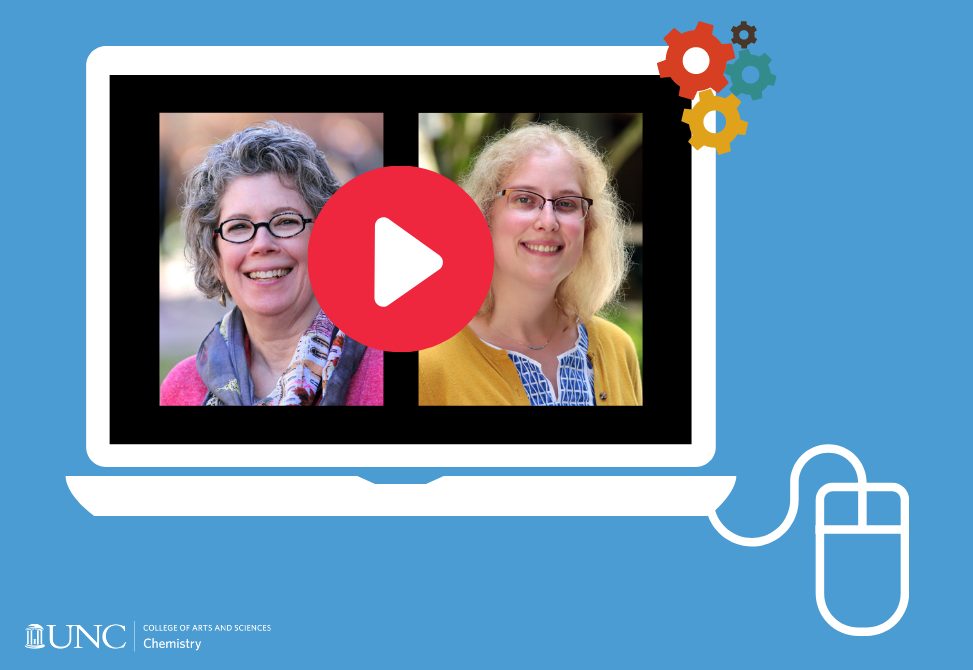Teaching professors adapt learning model for virtual classroom to cultivate supportive learning environment for students

Pictured, from left: Carribeth Bliem and Anna Curtis
March 24, 2021
By Alice Zhao, UNC-Chapel Hill Chemistry Communication
In March 2020, faculty, staff and students alike made the transition to a virtual environment. Our homes soon became classrooms and workspaces. This new normal offered some a greater comfort of a shorter commute; however, for some, the remote world became a little too “close to home.” The latter situation was what most incoming students faced. For first-year students, the hustle and bustle of move-in days, first meals at the dining hall and the decades-old tradition of taking a sip from the Old Well right before their first class were now unheard of. The byproduct of virtual semesters understandably left them feeling unmotivated as they learned how to adjust to a new normal.
Last spring, the pressure was on for teaching professors Carribeth Bliem, Anna Curtis and their colleagues. They had only days to prepare for a complete transition from a physical to virtual classroom. They quickly integrated Slack as a virtual workspace for teaching professors at Carolina Chemistry, using the platform to communicate to each other about available resources and how to help students make a similar transition.
“I think most students felt the same frustration that we did as faculty. Things had changed so abruptly and so completely. They also had to learn how to use technology and accept the limitations of that new technology,” said Bliem.
The two professors have studied how students learned over the past three remote semesters and adapted a high structure active learning model (HSAL), previously used on-campus, to help keep their students engaged. HSAL operates by providing students material prior to class and using class time for “active learning.” Students thus attend class well-prepared and spend time focusing on developing problem-solving skills. In the adapted model, Bliem and Curtis implemented several structures of interaction and support between students, their instructor and peer mentors. They presented their findings in a poster presentation titled, “Transitioning active learning from in-person to online in Introductory Chemistry.” Please see below for their adapted learning model.
- Student-expert interaction
- Peer mentors provide support during work in small groups
- Instructors lead class discussion following group work
- Problem-solving sessions are overseen by instructors, teaching assistants and peer mentors
- Student-content interaction
- Foundational content is provided via pre-class reading, pre-recorded lectures and online assignments
- Online homework and recommended textbook problems are assigned after class
- Student-student interaction
- Nearly 50% of class meetings are spent in small-group problem-solving sessions
- Sakai discussion boards
To accommodate large classes sizes of up to 400 students, students were assigned randomly to breakout rooms for problem-solving sessions. Bliem and Curtis used surveys to assess how students responded to the adapted model. They found that randomly assigned breakout rooms posed an issue of inconsistency for student interaction. Students preferred to be in a group with familiar faces. In response, Bliem and Curtis implemented pre-assigned breakout rooms in the Fall of 2020.
Initially, to accommodate the large number of students, they split their 50-minute synchronous classes into two 25-minute synchronous classes. They used Sakai, UNC’s online educational platform, to further promote engagement and discussion. In the asynchronous sessions, students are given pre-recorded lectures and warms ups on mastering chemistry. They then go into the synchronous portion well-prepared to focus on developing problem-solving skills. With an increase in the number of participants allowed in Zoom breakout rooms, Bliem and Curtis were able to return to meeting with all students on their roster for the full 50-minute class period this spring.
Though the two have found the adapted model to perform well in the virtual classroom, they will continue to refine it for the continued well-being of their students. In Curtis’ lecture courses, she sometimes uses a feelings chart to assess the emotional and mental well-being of her students. To further boost morale, Curtis assigns team names for the breakout rooms.
“We are here for our students. We are doing the best we can to help them learn. That is what I want to be more explicit about starting this spring [2021],” said Curtis.

